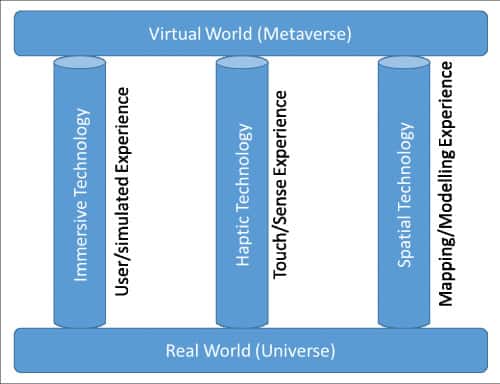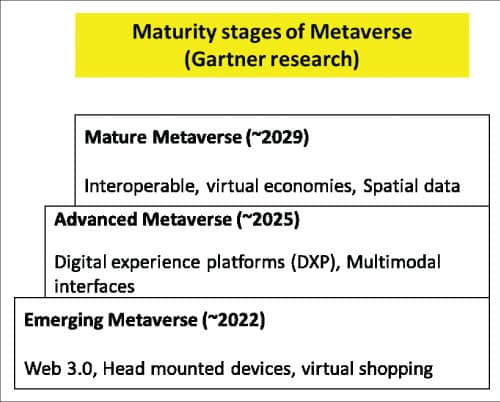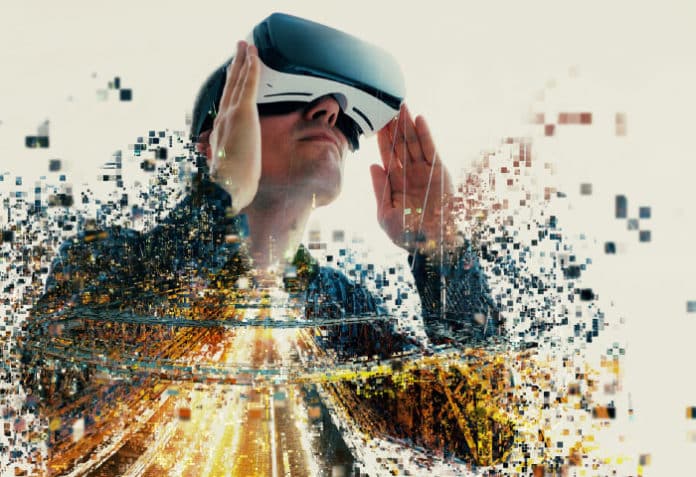The metaverse is no longer an unfamiliar term. The technology behind it is evolving each day and promises to engulf our lives in the years to come. We take a look at its history, evolution, applications and risks, as well as the top 12 metaverse platforms today.
When Facebook (now Meta) introduced the term ‘metaverse’ and the technology behind it, many companies began evolving strategies to implement it for their business solutions. Metaverse combines decentralised technology such as distributed ledger technology (DLT), non-fungible tokens (NFTs) and Web3 to enable secure, robust and resilient architecture. It also uses immersive, haptic and spatial technology to bring the user from the physical world into the virtual world.
Immersive technology is based on two principles — augmented reality (AR) and virtual reality (VR) — to merge the physical world with a virtual, digital or simulated reality.
Haptic technology is a 3D touch sense technology, also known as kinaesthetic communication. It is used to create the sense of touch through virtual application of force, vibration or motion.
Spatial technology or geospatial technology helps to map a location by studying its position, size and area. This helps to localise the user experience.
Metaverse technology is the latest buzzword, and many organisations believe that it can disrupt their IT policies, customer experience and market reach. However, there is a concern that metaverse may be over-hyped and we may be overthinking about metaverse enabled solutions. While we cannot overlook this technology, understanding its industrial applications and popular use cases will help us comprehend its impact better.

Though metaverse is the talk of the town since the last two years, it is not a new concept. In 1992, Neal Stephenson’s fictional work ‘Snow Crash’ talked of digital avatars in a parallel digital world, with whom humans could interact. This was perhaps the first time that something like the metaverse was envisioned.

In June 2021, the famed venture capitalist Matthew Ball released a nine-part series of essays titled ‘The Metaverse Primer’. He defines metaverse as a “massively scaled and interoperable network of real-time rendered digital world.”
Examples of how metaverse tech is being used
Metaverse technology has led to a number of industrial solutions, one of which is a banking solution named MetaFi (metaverse for financial services). Here, a personalised avatar interacts with customers for services like core banking, wealth and asset management, and retail banking. Recently, Tintra announced that it is developing a new-age Web3 solution called Metaverse Bank that offers fully-functional private and investment solutions for end users with immersive services.
In Japan, virtual games played over the network were very popular for a long time. These ‘Manga’ games later transformed into massively multiplayer online (MMO) interactive 3D games. The popularity of Microsoft’s HoloLens and Mesh prove that there is a huge market for gaming.
Axie Infinity (AXS) and Smooth Love Potion (SLP) have converted crypto-tokens (earned from virtual games) to ETH and then to USD. This is a new business model for earning through the digital world.
Tardiworld has hosted virtual marriage receptions, with friends and relatives attending from across the world. Gifts are being given as cryptocurrencies through the Zionverse platform. And an art event was hosted on the NextMeet platform by Broward College, Florida, USA.
Second Life platform has introduced a metaverse social platform for making new friends and interacting with them. LokaLocal has introduced virtual touring through a metaverse world that has 3D real-world images of cities and places.
The metaverse has been conceptualised by various platforms for training, education and virtual collaboration, healthcare, banking, financial services and retail sectors for an improved customer experience and to spread the reach of businesses.
The different stages of maturity of metaverse platforms
Metaverse promises to be a disruptive technology over the next five years across many sectors. Its early adoption is envisaged in home office and collaborative platforms, and in virtual training and education services. As per Gartner, the different maturity stages of metaverse are:
- Technology using Web3, head-mounted devices, and use cases like virtual shopping — this is the ‘emerging metaverse’ which we are experiencing currently.
- Technology developed for digital experience platforms (DXP), multi-modal interfaces and immersive experience systems — this is the ‘advanced metaverse’, a stage we can expect to reach by 2025.
- Technology that is interoperable using digital currency, blockchain, security and compliance for the crypto economy (and uses spatial data) will be part of the ‘mature metaverse’, a stage that will be reached by 2029.
The future
The metaverse promises to evolve into something very similar to our real world, and may even replace some real-world activities.
A few metaverse non-fungible token (NFT) vendors have enabled their NFTs to be used on some metaverse games for clothing and footwear; others are planning to do so. An increasing number of NFT enthusiasts are also sensing opportunities to invest in virtual lands on such games, and sell or rent them for a price. The metaverse can be a huge contributing factor to the growth of the virtual economy, which depends on video games and virtual worlds.
If NFTs are incorporated as in-game assets, decentralisation of the virtual economy can become a reality. Today, we already have a nascent version of the metaverse with NFTs representing popular art and digital memorabilia being lapped up by investors and crypto fans alike.
With major players like Meta entering this space and confidently signalling a great future for it, it is only a matter of time before others follow suit. This could lead to an exponential expansion of the boundaries of the metaverse and unlock vast volumes of value hitherto unknown to consumers and investors alike.
The future of the metaverse also rides on the idea of it running openly, almost without any interruption from a single community or company, with brands from across the world opening their outlets on it, just like they have done on the internet today.
The Top 12 metaverse platforms
In our opinion, the following are the top 12 metaverse platforms today.
Altspace VR: Acquired in 2017 by Microsoft, this virtual platform enables the creation of virtual events and is part of the tech giant’s mixed reality division. Users can host a meetup, a show or a class.
BlueJeans: BlueJeans from Verizon is a video platform designed to optimise flexible work in enterprises and mid-sized businesses. In 2021, the company partnered with MootUp to reimagine “virtual events in the era of the metaverse with 3D, VR and AR immersive environments, avatars and AI chatbots.”
Cryptovoxels: Cryptovoxels is a virtual world gaming platform powered by crypto and the Ethereum blockchain. It includes real-life infrastructure such as roads and buildings.
Gather: Gather is focused on video chat that builds a virtual layer over the physical world. It is an enterprise-specific offering that mimics an office construct and deeply integrates with video conferencing.
Metahero: Metahero, from Web 3 company Pixel Vault, is a universe where anyone can be a hero. The platform offers six different kits with avatars that can be customised and personalised.
Meta Horizon Worlds and Horizon Workrooms: Meta (formerly Facebook) bills its fledgling metaverse Horizon platform as an “ever-expanding social universe” to hang out with friends and create your own worlds. Workrooms is the company’s mixed reality app for employee collaboration.
Nvidia Omniverse: The chipmaker’s virtual platform focuses on 3D design work on computer graphics, simulations and the creation of new worlds.
Roblox: Roblox’s vision is to give people a platform that empowers them to create their own experiences. “Our vision is to reimagine the way people come together to create, play, explore, learn and connect with one another.”
Rooom: Rooom specialises in enterprise virtual showrooms, 3D product presentations and virtual events that can be used by marketing and sales groups in verticals such as education, retail, life sciences and manufacturing.
Sandbox: Sandbox is a community-driven gaming platform built on the Ethereum blockchain. Creators can monetise voxel assets.
Second Life: Second Life’s Metaverse City bills itself as “a welcoming role-play community” with immersive experiences that let players come in and out as they like. It’s a relatively unsecured space.
Somnium Space: Open source platform Somnium Space is termed as more of a consumer gaming platform. Users can purchase digital land parcels and build homes and buildings, as well as start businesses, among other activities.
The risks
While the metaverse seems exciting and enjoyable, it has its own set of risks and drawbacks.
Harassment and cyberbullying: Young adults and teens are vulnerable to cyberbullying. Its impact, which can range from a feeling of low self-worth to suicidal impulses, particularly among teens, has been well-documented. According to experts, because the human experience in the metaverse is as genuine as in the physical world, pain and suffering too are as real and severe.
Some hazards are more difficult to prevent in a virtual environment. Many free-to-play games, for example, rely on advertisements to fund their growth. Malicious people may hypothetically replace these advertisements with images that cause sickness, which may be sent to a virtual reality headset.
Theft of identity: Many experts are afraid that if rigorous security measures are not adopted, identity theft in the metaverse may become even easier. In the real world, identity theft is now a multibillion-dollar industry, with damages being estimated at US$ 24 billion.
Collection of unauthorised data by companies: Your personal information is today collected by legitimate businesses. Virtual reality, on the other hand, has the potential to push data collection to a new level. Virtual reality headsets, for example, may hypothetically allow third parties to collect sensitive personal data including voiceprint data, biometric data, and even facial geometry data.
Ransomware attacks: Ransomware is malicious software that encrypts your data and prevents you or anyone else from accessing it. It will then display a message demanding you to pay a particular amount of money to regain access to your data, thus the term ‘ransomware’. Your metaverse profile will have a lot more information than a regular social media page; it will also include a lot of sensitive information. Hence, such attacks will have a much larger impact.
A change in real world perceptions: According to a study done at Stanford University, both virtual reality and augmented reality, two of the foundations of metaverse, can influence how individuals see the actual world. Participants in that study, for example, avoided sitting in a chair where a computer-generated avatar had sat in their AR environment.
Deepfake videos: In a world where information is king, experts are concerned about bogus information campaigns delivered via deep falsified audio and video snippets, endangering a country’s security. Deepfakes are modified video or audio clips that appear and/or sound like someone else.
Attacks using social engineering: The activity of mentally influencing someone into giving sensitive information is known as social engineering. Because of the large quantity of personal data that will be kept in the metaverse, it might become a gold mine for hackers trying to sell personal data on the Dark Web. Education will be the foundation for metaverse security management.
Shared spaces come with their own set of dangers: The metaverse is built on the idea of bringing people together. While this might be beneficial in certain respects, it can also raise issues. In the metaverse, you will have to deal with people who have contrary viewpoints. People behave differently in a virtual environment than they do in the actual world, according to studies. This is particularly evident in the field of massively multiplayer online role-playing games (MMORPGs), where veteran players frequently criticise newcomers and even abuse girls.
New applications will need to be vetted: New apps, like today’s internet, have the potential to disrupt our digital life, leading to digital risk. The enormous volume of sensitive data that will be retained in a metaverse scenario, however, can make the damage considerably worse. We’ll need to come up with ways to ensure that all new apps are scanned for harmful code.
Key technologies integrated with the metaverse platform
Blockchain: Blockchain technology forms the bedrock of the metaverse, as most of the applications run on blockchains. It provides the decentralisation and transparency that is necessary for the functioning of the metaverse. Blockchain technology helps developers integrate several functions in the metaverse such as digital ownership verification, value transfer, governance, digital collectability, accessibility and interoperability.
Cryptocurrency: Cryptocurrency is one of the primary technologies used in the metaverse. The platforms on metaverse only accept cryptocurrencies. So, users have to change their real-world currencies to crypto before they can carry out any transaction in the metaverse. It can be used to purchase resources such as NFTs, digital real estate and to make in-game purchases. In the metaverse, cryptocurrencies have massive value. For example, if you want to buy a plot of land on Decentraland, you will have to convert your real-world currency to MANA, the native token of the game. It’s the same story for all the games and platforms on the metaverse.
Augmented reality and virtual reality: Augmented reality (AR) and virtual reality (VR) engines play an important role in enabling the metaverse to be an enthralling virtual experience. They help create immersive and engaging 3D environments for the metaverse.
While VR and the metaverse might seem like the same thing, there are certain differences between the two:
- VR is only a part of the broader metaverse. The metaverse is made up of several other technologies that complement VR technology.
- While VR enables users to see 3D simulations, the problem is that VR technologies cannot provide physical stimulations, which is an important part of the metaverse.
This is where AR comes in. It helps expand the scope of the metaverse by enabling users to actually feel things by creating physical stimulations. As a result, users can hear, feel and interact with the virtual metaverse as if they are physically present in it. The combination of VR and AR technologies is likely to create a more realistic metaverse and bring in massive investments from various companies.
Artificial intelligence (AI): AI has become an inextricable part of our lives — from Alexa and Siri to the smart sensing air conditioner that helps us sleep. So, it is only expected that the metaverse will also use AI to improve its performance.
AI plays a major role in making every process that happens in the metaverse an immersive one. It can help process data at lightning speed with the aid of machine learning techniques. Within the metaverse, prior historical data can be used by AI algorithms to create unique outputs and insights. Another important use of AI in the metaverse is to create metaverse avatars. AI engines can analyse 2D and 3D images to generate more realistic looking and accurate avatars. AI can also add more character by helping create different facial expressions, hair styles, clothes, and features to enhance the appearance of the avatars.
Internet of Things (IoT): IoT enables applications to collect data and feed it to the metaverse to adjust more precisely to real-world conditions. For example, weather or temperature data collected via IoT can help the metaverse adjust its environment.
Another advantage of IoT is that it can seamlessly connect the 3D world to a large number of devices from the physical world, enabling real-time stimulations in the metaverse.
IoT can also use AI and machine learning algorithms to further improve on and optimise the metaverse environment by managing the data that it collects.
Edge computing and 5G communications: Edge computing basically facilitates faster data transfer with fewer delays and helps enable smoother experiences. It is one of the primary factors that has enabled the metaverse to be viable, as computers need to handle the intense stimulations with efficiency to reduce lag and ensure that users have an immersive and unhindered gaming experience.
Another important feature that is often combined with edge computing is the availability of 5G networks. Previously, users often faced issues with their network while engaging in the metaverse due to slow data transfer speed resulting from unavailability of fast internet speed. However, with 5G being rolled out and made available at affordable rates, users can experience the metaverse from their desktops and other devices without facing a lag due to network speed.
Together, edge computing and 5G enable users to engage in the metaverse and enjoy a truly immersive experience.an










































































